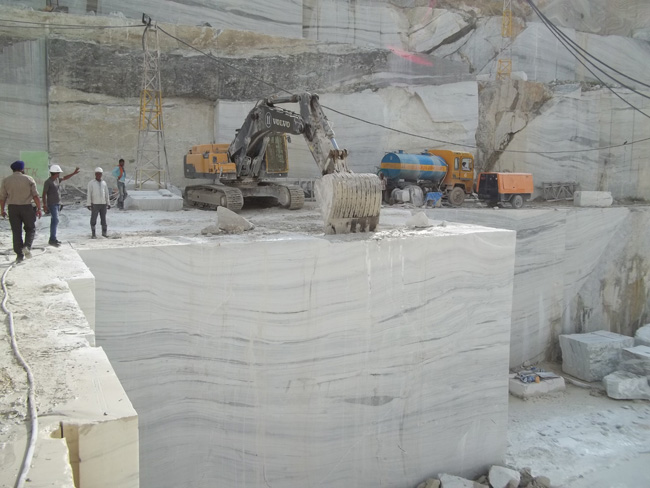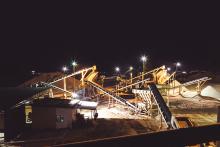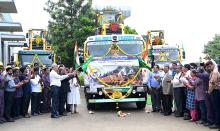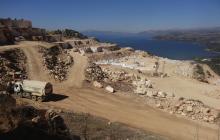
A major marble-mining region in northern India is benefiting from rising production volumes and improved operational efficiency thanks to mine operators’ adoption of advanced technologies. Partha Pratim Basistha reports.
The scenic northern India state of Rajasthan is renowned for its high-quality limestone reserves. It is also famous for its colossal marble reserves. There are between 800-1200 marble mines at Morwad in Rajasthan’s Rajasmand district, contributing close to 72% of India’s domestic white marble production.
One of the major marble mine owners in the area is RK Marble. The company also owns one of India’s major cement-producing firms, Wonder Cements, which has its main plant in Rajasthan. RK Marble has produced marble blocks from mines leased by the state government of Rajasthan since 1994. The company has one more adjoining marble mine at Dharmeta, close to Morwad, and another mine at Baswada, bordering Rajasthan and the state of Madhya Pradesh.
RK Marble achieved global recognition in 2001 for producing a world annual record 1,059,540tonnes of marble blocks from its Morwad mine.
“Production of record volumes of marble was enabled through adaption of advanced mechanisation. This was mainly for marble block handling through acquisition of three
RK Marble and other leading marble producers in Morwad increasingly prefer to use wheeled loaders over derrick cranes to load marble blocks on to flatbed trailers. This is for several reasons. Firstly, derrick cranes, being stationary equipment installed on the marble bench, are cumbersome when it comes to loading marble blocks on trucks. This is mainly due to derrick cranes’ 33.5metre restricted boom length, 20-50tonne maximum lifting capacity and 270° turning radius. These factors made it difficult to load the blocks from the foot of the bench on to the trucks. The trucks could not access the benches due to restricted access.
Secondly, with restricted turning radius and loading capacities the derrick cranes could not properly arrange the marble blocks on the mine surface. Instead, they had to place the blocks close to the bench from where they had been extracted, causing block pile-ups. This also made it difficult for trucks to park close enough to the bench to ensure efficient loading.
Marble mines have also been getting deeper, making it highly unsafe for loaded trucks to travel back to the surface and further on to the processing sites. There have also been many instances of derrick cranes collapsing and endangering life, even leading to fatalities.
Anil Kumar Sharma, a senior general manager at RK Marble, said: “Usage of wheeled loaders with the block handler attachment kit facilitates block loading with ease. The other major advantage we found utilising wheeled loaders is the faster material cycle times they allow, due to the ease with which they can position themselves on site. Blocks, mainly sized 3-30tonnes, can be arranged quicker and more easily transported to the surface for loading on to trailers. Given these multiple advantages, we have now done away completely with 12 derrick cranes that were placed across 40 hectares of our marble mines in Morwad.”
“Advanced levels of wheeled loaders, excavators and haulage solutions bought on a regular basis by us based on thorough evaluation of operational parameters, have contributed greatly to our ability to maintain high levels of marble production across our three mines,” says Sharma. Morwad mines produce 1 million tonnes/year of marble.
Phasing out its Cat 988F wheeled loaders, RK Marble acquired two Cat 980H wheeled loaders in 2011 and one Cat 988G in 2005 for Morwad. The firm also acquired for Morwad one
The excavators are used for handling and loading overburden materials on to rigid dump trucks (RDTs) and for positioning marble blocks on site.
A further major acquisition was made by RK Marble in 2016 with the procurement of two Hitachi Zaxis 472, two Zaxis 450 and three Zaxis excavators for Baswada Marble mines. “Performance of the Hitachi Zaxis excavators has been excellent in terms of productivity, reliability, fuel efficiency and ease of maintenance and operation due to lesser levels of automation,” says Sharma.
Key marble mines in the Rajasthan region have also witnessed advances in transporting overburden materials. Eight Volvo FM 400 rigid dump trucks bought in 2011 are working in RK Marble’s Dharmeta mines. “The trucks are outstanding in their performance in terms of productivity, tipping stability and, most significantly, required speed to haul the overburden materials through the long steep gradients of the mines.”
RK Marble has been using Volvo FM7 and FM9 rigid dump trucks. It had close to 40 rigid dump trucks bought in 2000, most of which have been phased out of use. The models had been fitted with water sprinklers to help restrict dust in the mines.
In Morwad mines, RK Marble operates 12 Tata Hitachi Euclid EH 600 40tonne RDTs bought in 2010.
Normally, the process of marble extraction consists of drilling a 18cm hole with a rock drill or jack hammer on the top of the bench. A similarly-sized hole is drilled on the side of the bench. An 11mm diamond wire saw or chainsaw is inserted in the holes for cutting the bench open. This is followed by inserting air or water bags inside the gap of the bench to make it 30.5cm-45cm wide to accommodate the excavator bucket teeth and push open the bench - which takes 10-20 hours. After using, in most cases, two to three hydraulic excavators to push open the bench, extracted 35-40tonne marble blocks are cut down for further processing. Processing involves cutting the blocks with saws and polishing them as per the dimensional requirements of the buyers. If the face or top of the bench is covered by earth or rocky materials, controlled blasting is done to access the bench. Weight of the bench for extraction is between 800 and 1,000tonnes.
Arora’s JK Natural Marbles, one of the oldest and biggest marble producers in northern India, has also incorporated higher levels of mechanisation into its production process. Now run by the third generation of the founder’s family, JK Natural Marbles first acquired its mines on lease from the Rajasthan government in 1979.
In 2004, JK Natural Marbles was among the first of the Rajasthan marble mine producers to acquire Volvo wheeled loaders. The business currently owns two L220 Volvo and one
JK Natural Marbles produces four marble variants - J.K Brown, Bianco Vento, Verdure and Silver Cloud. As well as selling its marble products domestically, the firm exports to the U.S., China, Turkey and the Middle East.
Vikram Arora, a JK Natural Marbles director, proudly says: “We have recently received an award from the Federation of Indian Mining & Mineral Industries for the adoption of the best mechanisation in marble mining in India. We will continue to make production cost competitive through adoption of higher levels of technological advancements. This, in turn, will give our customers greater value.”
JK Natural Marbles produces 14,000-15,000tonnes/month of marble. The firm owns an impressive fleet of 16 excavators for marble block extraction and handling of overburden materials. It consists of 13 Volvo models: one EC 210, two EC 350, four EC 360, five EC 380 and one EC 480; two
Due to lower than national average rainfall in Rajasthan, JK Natural Marbles stores rainfall water in reservoirs located near to the mines. Pumps are used to convey the water into the bench areas to assist block cutting with diamond wire saws.
In 2017, JK Natural Marbles purchased three new generation Volvo FMX 460 RDT with I-Shift automated gearbox for transporting overburden materials.
Parminder Singh, a plant manager for JK Natural Marbles, said: “The I-Shift automated gearbox technology, with crawler gears optimised for tough and time-constrained operations, ensures precise torque from the engine is available to the [RDT] wheels through the electronic controls units. This is even when the trucks are carrying heavier overburden loaders on slippery and steeper gradients from the pit to the surface. This makes the FMX 460 highly suitable to our requirements.” JK Natural Marbles also owns five Volvo FM00 18.5m³ body RDTs.
Vikram Arora says: “Extraction has greatly benefited from advances in excavator undercarriages, booms and hydraulics. As we have expanded our operations, our staff have also benefited from excavator operator training by manufacturers. Telematics tools like Matrix, featured in the Volvo excavators, have provided us with real-time information, especially around fuel consumption. This has given us better scope to evaluate machine control and optimise machine utilisation.”
As well as adding extensive value to Indian marble mining through their extraction and overburden materials-handling work, excavators are also used in Morwad sites to push extracted marble blocks away from the bench. Excavators are also occasionally employed for loading marble blocks on to trailers.
Subhash Sharma, assistant general manager, sales & marketing at Volvo India’s North India office, feels strongly that the use of marble block positioning and handling by excavators is not appropriate, as it can cause them severe damage.
“Carrying the heavy marble blocks in the [excavator] buckets along a hard mining surface damages the carriages, underframe and track drives. Damage is also caused to the boom and the arms, and exerting force to push the blocks results in higher fuel consumption. Furthermore, pushing the blocks with the excavators causes heavy damage to the corners of the marble blocks, due to the rubbing of the track chain. Most importantly, this process of block handling is highly time consuming and capital intensive, with mines tending to use four excavators for the job.”
Sharma believes excavators should be exclusively used for loading overburden materials and toppling blocks from the bench. He argues that marble blocks are best handled by wheeled loaders. The loaders can also be utilised for pushing the blocks from the bench with pusher kits, followed by arranging them on the site and further loading on the trailers with block handler attachments.
Sharma says one loader can easily replace three to four excavators. Usage of loaders will also help extend the working life of excavators. Bigger mine owners are gradually realising the usefulness of wheeled loaders, leading to rising sales. However, there are many small mines at Morwad, Baswada and Dharmeta that continue to prefer excavators, as they find them more economically viable to own and operate.










